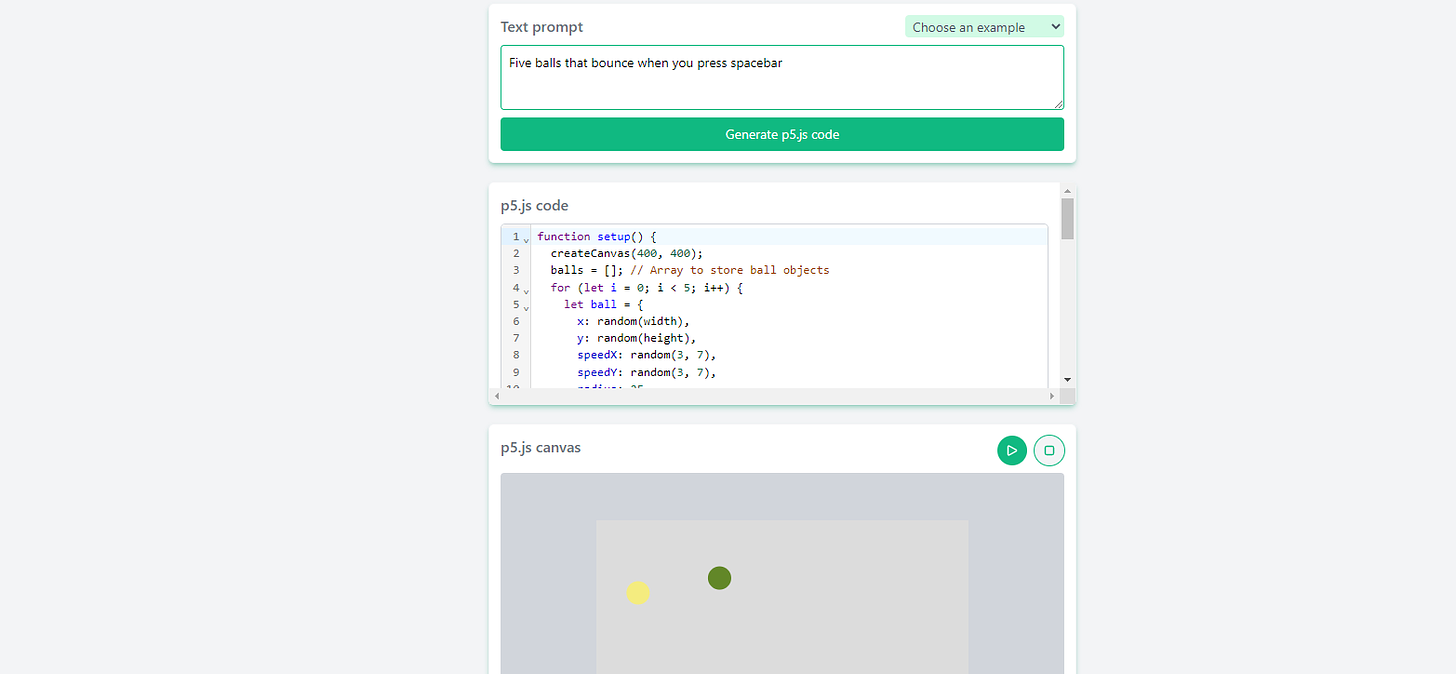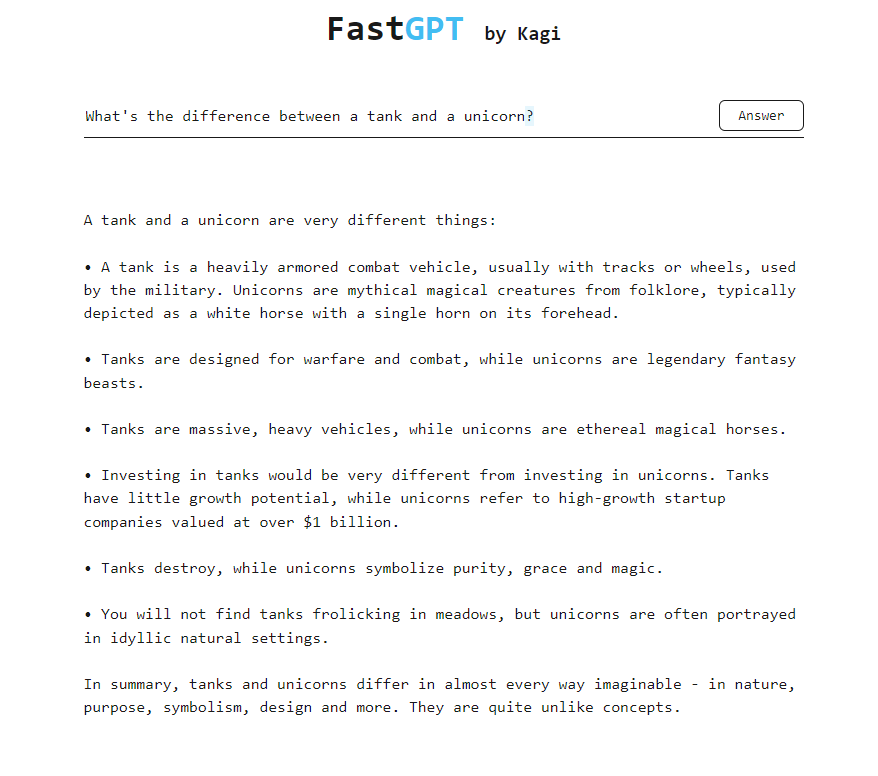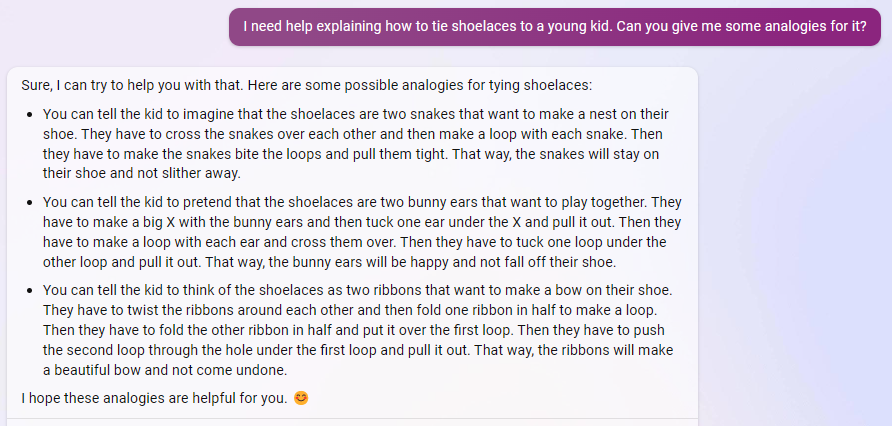10X AI (Issue #2): Bard Coding, AI Music, Speedy Alternative to ChatGPT, and a Bush
Plus a look at Track Anything, new AI features in Microsofft Designer, LLM from Hugging Face, as well as more voice cloning and coding tools powered by AI.
Happy Sunday!
Welcome to the second edition of 10X AI, where I look at recent AI developments, tools, and tips with a focus on beginner users.
Let’s dive right in.
AI news
Here are this week’s AI developments.
1. Bard’s a pro coder now?
Google’s Bard may be lackluster when compared to GPT-4 on language tasks…but perhaps it’ll have better luck helping you code? At least Google thinks so. The company apparently injected a bit of coding magic into Bard, claiming it should now be able to help with code generation and debugging:
We’re launching these capabilities in more than 20 programming languages including C++, Go, Java, Javascript, Python and Typescript. And you can easily export Python code to Google Colab — no copy and paste required.
Sadly, I’m in Denmark, so I have the distinct pleasure of seeing this message:
So if you’re in the US and get your hands on Bard, I’d be curious to hear how it actually fares when it comes to coding tasks.
2. Track Anything lets you track…anything
Just two weeks ago, Meta entered the AI game with their Segment Anything Model (SAM), which can automatically identify and “cut out” any object in an image.
Now, Track Anything has built on SAM to give you the ability to consistently track an object in a video. One of its cooler applications is the ability to seamlessly remove something or someone from the video altogether. (Stalin would’ve been delighted.)
You can try Track Anything for yourself in this Hugging Face demo.
And speaking of Hugging Face…
3. Hugging Face releases Hugging Chat
Up to now, Hugging Face was best known for being a platform that hosted all sorts of third-party AI models and demos. Now, the company has entered the fray with an LLM offering of its own: Hugging Chat.
While it can’t quite compete with the big boys like ChatGPT and GPT-4, Hugging Chat is a completely open-source, free-to-use model that anyone can repurpose.
Curious? Check out the demo.
4. Music: the next frontier in generative AI?
AI-generated music isn’t exactly new.
I touched upon it in October 2022, demoed a model called Riffusion in December, then covered Google’s MusicLM back in February this year. I also toyed with Drayk.it (now defunct) to make goofy stuff like a fake Drake song about insomnia.
But music AI is really hitting the mainstream now.
About two weeks ago, a fake Drake and Weeknd song stirred controversy for copyright infringement.
Then, Grimes famously Tweeted:
I'll split 50% royalties on any successful AI generated song that uses my voice. Same deal as I would with any artist i collab with. Feel free to use my voice without penalty.
Then Vice ran an article about AI Hub, a Discord with thousands of AI music producers. Then Spotify CEO Daniel Ek called AI music “cool and scary” and acknowledged its likely major impact on the industry.
In short, it looks like music generation is the new hot topic within AI, so keep your eyes peeled.
Oh, and if you were wondering…of course there already are multiple radio stations that play AI-generated songs. Enjoy.
5. Microsoft Designer: now with magic fAIry dust
Not to be outdone by Adobe Firefly, Canva, and the rest of the AI-assisted graphic design field, Microsoft recently released new AI tools within Microsoft Designer and teased more upcoming features.
Go to designer.microsoft.com to give it a try.
AI tools
Check out this week’s selection of beginner-friendly AI tools.
6. Text → GPT → p5
I recently showed how easy it’s become to do basic coding with ChatGPT or Bing Chat. (Even if you don’t know the first thing about coding.)
But the Text → GPT → p5 tool is for the ultra-impatient. It takes things from prompt to p5.js code to visualization in a single screen.
Simply describe what you need with words, watch it generate the necessary code, and test whether it works right on the canvas without ever leaving the site.
Really neat!
7. FastGPT
Speaking of being impatient.
FastGPT is a chatbot that strives to be the fastest on the market. In my limited testing, it delivers in spades. It’s way ahead of ChatGPT and Bing Chat when it comes to both the initial response time and typing speed. So points for quick responses!
8. Play.ht
AI-powered text-to-speech has also been around for a minute. ElevenLabs seems to be the market leader at this stage. But its voice cloning tool costs money.
Play.ht, on the other hand, lets you test voice cloning for free.
Disclaimer: Voice cloning requires uploading a rather long speech sample, so I haven’t had the chance to try it out myself. If you do, I’d love to hear about your impressions.
AI tips
Just a single tip this week.
9. Get useful analogies for anything
Stuck trying to explain a concept to someone? This is a real world situation where LLMs serve a clear practical purpose. Both ChatGPT and Bing Chat are great at coming up with analogies for just about anything.
You can even tailor these analogies to the exact audience and purpose:
10. AI fail of the week
This is not the bush I was looking for.
Join me on Notes?
One more thing.
Substack recently introduced a so-called “Notes” feature, which is a sort of Substack-only social media space for writers and their subscribers.
I’m not extremely active there at the moment, but if you want to ask me questions, discover other Substack writers to follow, or discuss things with your fellow AI enthusiasts, it’s worth checking out.











